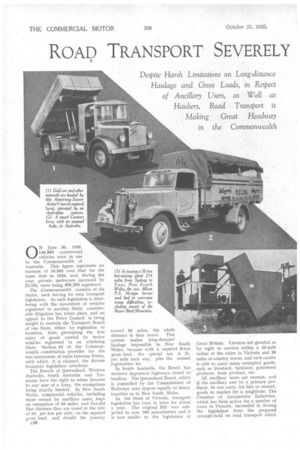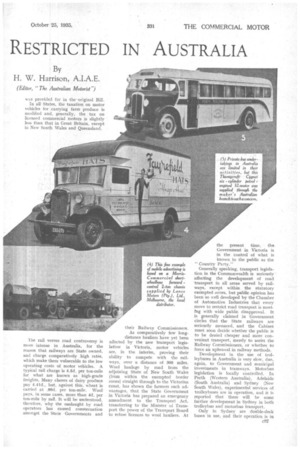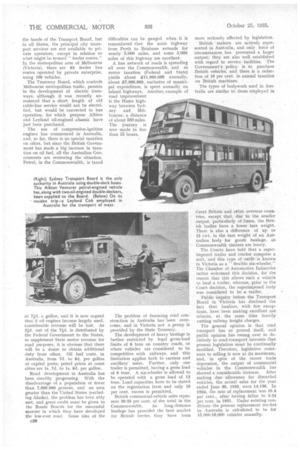ROA') TRANSPORT SEVERELY RESTRICTED IN AUSTRALIA
Page 78

Page 79

Page 80

If you've noticed an error in this article please click here to report it so we can fix it.
Despite Harsh Limitations on Long-distance Haulage and Gross Loads, in Respect of Ancillary Users, as Well as Hauliers, Road Transport is Making Great Headway in the Commonwealth ON June 30, 1935, 146,883 commercial vehicles were in use in the Commonwealth of Australia. This figure represents an increase of 10,992 over that for the same date in 1934, and, during the year, private motorcars increased by 25,320, there being 459,258 registered.
The Commonwealth consists of six States, each having its own transport legislation. As such legislation is interfering with the movement of vehicles registered in another State, considerable litigation has taken place, and an appeal to the Privy Council is being sought to restrain the Transport Board of one State, either by regulation or taxation, from preventing the free entry of goods carried by motor vehicles registered in an adjoining State. Section 92 of the Commonwealth constitution provides for the free intercourse of trade between States, with which, it is claimed, the diverse transport legislation interferes.
The Boards of Queensland, Western Australia, South Australia and Tasmania have the right to refuse licences to any user of a lorry, the exemptions being strictly limited. In New South Wales, commercial vehicles, including those owned by ancillary users, haze an exemption of 50 miles, and beyond that distance they are taxed at the rate of 3d. per ton per mile, on the reputed gross load, and should the journey c36
exceed 50 miles, the whole distance is thus taxed. This system makes long-distancehaulage impossible in New South Wales, because with a reputed 8-ton gross load, the special tax is 2s. per mile each way, plus the annual registration fee.
In South Australia, the Board has declared important highways closed to hauliers. The Queensland Board, which is controlled by the Commissioner of Railways, may impose equally as heavy taxation as in New South Wales.
In the State of Victoria, transport legislation has been in force for about a year. The original Bill was subjected to over 100 amendments and it is now similar to the legislation in Great Britain. Licences are granted as by' right to carriers within a 25-mile radius of the cities in Victoria and 20 miles of country towns, and each carrier is able to carry many exempted goods, such as livestock, furniture, petroleum products, farm produce, etc.
All ancillary users are exempt, and if the ancillary user be a primary producer, he can carry, for hire or reward, goods to market for a neighbour. The Chamber of Automotive Industries, which has been active for a number of years in Victoria, succeeded in freeing the legislation from the proposed strangle-hold on road transport which The rail versus road controversy is more intense in Australia, for the reason that railways are State owned, and charge comparatively high rates, which make them vulnerable to the low operating costs of motor vehicles. A typical rail charge is 4.5d. per ton-mile for what are known as high. grade freights. Many classes of dairy produce pay 4.41d., but, against this, wheat is carried at .99d. per ton-mile. Wool pays, in some cases, more than 4d. per ton-mile by rail. It will be understood, therefore, why the onslaught by road operators has caused consternation amongst the State Governments and their Railway Commissioners.
As comparatively few longdistance hauliers have yet been affected by the new transport legislation in Victoria, motor vehicles are, in the interim, proving their ability to compete with the railways, over a distance of 300 miles. Wool haulage by road from the adjoining State of New South Wales (from within the exempted border zones) straight through to the Victorian coast, has shown the farmers such advantages, that the State Government in Victoria has prepared an emergency amendment to the Transport Act, transferring to the Minister oi Transport the power of the Transport Board to refuse licences to wool hauliers. At
the present time, the Government in Victoria is in the control of what is known to the public as the " Country Party."
Generally speaking, transport legisla
tion in the Commonwealth is seriously affecting the development of road -transport in all areas served by railways, except within the statutory exempted zones, but public opinion has been so well developed by the Chamber of Automotive Industries that every move to restrict road transport is meetrng with wide public disapproval. It is generally claimed in Government circles that the State railways are seriously menaced, and the Cabinet must soon decide whether the public is to be denied cheaper and more convenient transport, merely to assist the Railway Commissioners, or whether to force an upheaval in railway methods.
Development in the use of trol leybuses in Australia is very slow, due, again, to Government and municipal investments in tramways. Motorbus legislation is locally controlled. In Perth (Western Australia), Adelaide (South Australia) and Sydney (New South Wales), experimental services of trolleyhuses are in operation, and it is reported that there will be some further development in Sydney in both trolleybus and motorbus transport.
Only in Sydney are double-deck buses in use, and their operation is in
the hands of the Transport Board, but in all States, the principal city transport services are not available to private operators, except in relation to what might be termed " feeder routes." In the metropolitan area of Melbourne (Victoria), there are 83 feeder bus routes operated by private enterprise, using 190 vehicles.
The Tramway Board, which controls Melbourne metropolitan traffic, persists in the development of electric tramways, although it was recently announced that a short length of old cable-line service would not be electrified, but would be converted to bus operation, for which purpose Albion and Leyland oil-engined chassis have just been purchased.
The use of compression-ignition engines has commenced in Australia, and, so far, there is no special taxation on oilers, but since the British Government has made a big increase in taxation on oil fuel, all the Australian Governments are reviewing the situation. Petrol, in the Commonwealth, is taxed
at 71(1. a gallon, and it is now argued that if oil engines become largely used, considerable revenue will be lost. As 21d. out of the 74cl. is distributed by the Federal Government to the States, to supplement State motor revenue for road purposes, it is obvious that there will be a desire to obtain additional duty from oilers. Oil fuel costs, in Australia, from 7d. to 8d. per gallon at capital ports; petrol prices at coast cities are ls. 7d. to Is. 8d. per gallon.
Road development in Australia has been steadily progressing. With the disadvantage of a population of fewer than 7,000,000 persons, and an area greater than the United States (excluding Alaska), the problem has been ably met, and great credit must be given to the Roads Boards for the successful manner in which they have developed the low-cost road. Some idea of the 038 difficulties can be gauged when it is remembered that the main highway from Perth to Brisbane extends for nearly 5,000 miles, and some 3,000 miles of this highway are excellent.
A fine network of roads is spreading all over the Commonwealth, and as motor taxation (Federal and State) yields about £11,000,000 annually, about £7,000,000, exclusive of municipal expenditure, is spent annually on inland highways. Another example of road improvement is the Hume highway between Sydney and Melbourne, a distance of about 580 miles. The journey is now made in less than 15 hours.
The problem of financing road construction in Australia has been overcome, and in Victoria not a penny is provided by the State Treasury.
The development of heavy haulage is further restricted by legal gross-load limits of 8 tons on country roads, or where vehicles are considered to be competitive with railways, and this limitation applies both to carriers and ancillary users. Further, only one trailer is permitted, having a gross load of 6 tons. A six-wheeler is allowed to be operated with a gross load of 13 tons. Load capacities have to be stated on the registration form and only 10 per cent, excess is permitted.
British commercial-vehicle sales represent 20-25 per cent, of the total in the Commonwealth. As long-distance haulage has provided the best market for British lorries, they have been more seriously affected by legislation.
British " makers are actively represented in Australia, and only force of circumstances has prevented a larger output; they are also well established with regard to service facilities. The Government's policy is to purchase British vehicles, and there is a reduction of 10 per cent, in annual taxation on British machines.
The types of bodywork used in Australia are similar to those employed in
Great Britain and other overseas countries, except that, due to the smaller Output, particularly of buses, the British bodies have a lower tare weight. There is also a difference of up to 15 cwt. in the tare weight of an Australian body for goods haulage, as Commonwealth timbers are heavy.
The Courts have held that a superimposed trailer and tractor comprise a unit, and this type of outfit is known in Victoria as a " flexible six-wheeler." The Chamber of Automotive Industries rather welcomed this decision, for the reason that this allows such a vehicle to haul a trailer, whereas, prior to the Court decision, the superimposed body was considered to be a trailer,
Public inquiry before the Transport Board in Victoria has disclosed the fact that hauliers, with few exceptions, have been making excellent net returns, at the same time heavily cutting railway freight charges.
The general opinion is that road transport has so proved itself, and public opinion has swung over so decisively to road-transport interests that present legislation must be continually modified. Therefore, legislative resistande to selling is now at its maximum, and, in spite of the recent trade depression, the output of commercial vehicles in the Commonwealth has showed a considerable increase. After making due allowance for discarded vehicles, the actual sales for the year ended June 30, 1935, were 14,136. In 1934, the rate of replacement was 10.4 per cent., after having fallen to 3.24 per cent. in 1931. Under existing conditions the present replacement market in Australia is calculated to be for 15,000-16,000 vehicles annually.
















































































































































